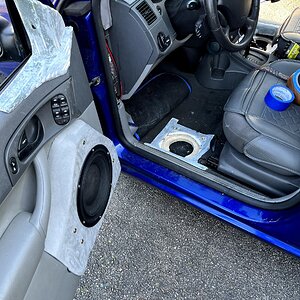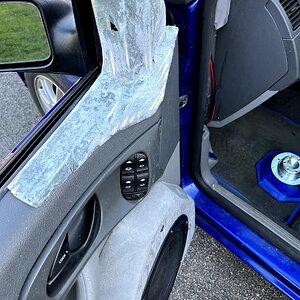Archer3545
CarAudio.com Newbie
Part 1 TLDR: My question: I bought two 400w rms DVC 4ohm subs. I have a 800w at 1 ohm stable amp. If I wire the subs to a 1 ohm final load on the amp, that should mean that the amp is putting out 800 watts in total, but wouldn't the 4ohm resistance from the subs them self reduce that 800w to something lower therefore meaning if I want to hit that 800w rms total for both subs I should either buy another one of those amps or just get a new one alltogether?
Part 2 TLDR: When setting gain for sub with multimeter if the amp load is 1ohm but the speakers are 4ohm do I use 1 or 4 in the ohms law equation? The best I could find was to use the amp load so in my case 1ohm, which means to hit 800w rms I should set the gain to 28.28v, but on the manufacturer website for my amp it says RMS Power at 1 Ohm: 800 Watts x 1 Channel (14.4v) Does that mean with the gain set to 14.4v it's pushes 800 watts and if so why even use ohms law if it could ultimately be way off?
Part 1: So I bought a new amp for my sub the amp that I bought is a
Skar Audio RP-800.1D Monoblock Class D MOSFET Amplifier with Remote Subwoofer Level Control, 800W
https://www.skaraudio.com/products/rp-800-1d-car-amplifier
and the sub is a Skar Audio SVR-8 D2 8" 800 Watt Max Power Dual 2 Ohm Car Subwoofer
I've had the sub for a few months now and it's wook great for a little 8" sub, the previous amp I had was a good pioneer one that has worked well for about 6 months now, It matched my sub well and the reason I bought a new amp is mostly because I wanted something more reliable with a slightly smaller profile. Now for a long time I have been wanting to get more bass out of my system and I don't have much experience with subs, because this has been my first attempt and I live in a small town and there isn't really a way I can test different stuff out to fit my personal preference without buying it, so it's been a lot of trial and error to get to this point. I was really on the edge between getting a second 8inch sub identical to the one that I have, and I would buy the same skar amp that I just bought again as well. Know my intial thought process was if cone area is what makes 12" subs sound better than 8's and 12's aside from the fact that 12's can do lower frequencies, than maybe two 8" subs would be bette than a single 12" sub because more it has more surface area. I know I'm stupid give me a break it's been a few years since I have taken geometry. So I did reasearch and found that two 8" subs don't have more surface area than a sing 12 that actually have slightly less. That coupled with the fact that the sub I currently have is out of stock and I would have to wait an unknown amount of time to get it, drove me to semi-impulsivly buying two
Rockford Fosgate P2D4-12 Punch P2 DVC 4 Ohm 12-Inch 400 Watts RMS 800 Watts Peak Subwoofer
https://rockfordfosgate.com/products/details/p2d4-12/
Now the reason I said semi-impulsively is because I did my reasearch and I have looked at those subs in the past. Now to get to the point. The amp I bought is 1 ohm stable at 800w I have heard that higher ohms while yes have more resistance and therefor it is harder to get a lot of power at that ohm, but it is more stable and clean sounding. Regardless for the time being I want to run this amp at one ohm and I couldn't of done this if I went with the two 8" subs because they would of been D2 and you can't wire that down to 1 ohm at least not on a mono amp, but you can wire two DVC 4 ohm subs to one ohm and that's what I plan to do.
My question: I bought two 400w rms DVC 4ohm subs. I have a 800w at 1 ohm stable amp. If I wire the subs to a 1 ohm final load on the amp, that should mean that the amp is putting out 800 watts in total, but wouldn't the 4ohm resistance from the subs them self reduce that 800w to something lower?
Part 2: the best way I have to set the amp gain is to use ohms law and a multimeter. So V= the square root of (desired rms wattage x resistance of speaker load) But what is the resistance of speaker load for me? Do I use 1ohm because that's my amp load or do I use 4ohms because that's my speakers resistance? Now I googled what is resistance of speaker load in car audio and it came up with "Each voice coil has an impedance of 4 ohms which results in a 2 ohm impedance for each speaker. One speaker is connected to each channel of the amplifier. This is a 2 ohm stereo load." While that specific example is not related to my setup my best guess would be to use the amp load. so for it would be the square root of (800w rms x 1) = 28.28v but on the manufactures website for my amp under specifications it's lists each rms wattage at different omhs and it lists a voltage with it. https://www.skaraudio.com/products/rp-800-1d-car-amplifier
Part 2 TLDR: When setting gain for sub with multimeter if the amp load is 1ohm but the speakers are 4ohm do I use 1 or 4 in the ohms law equation? The best I could find was to use the amp load so in my case 1ohm, which means to hit 800w rms I should set the gain to 28.28v, but on the manufacturer website for my amp it says RMS Power at 1 Ohm: 800 Watts x 1 Channel (14.4v) Does that mean with the gain set to 14.4v it's pushes 800 watts and if so why even use ohms law if it could ultimately be way off?
Part 1: So I bought a new amp for my sub the amp that I bought is a
Skar Audio RP-800.1D Monoblock Class D MOSFET Amplifier with Remote Subwoofer Level Control, 800W
https://www.skaraudio.com/products/rp-800-1d-car-amplifier
and the sub is a Skar Audio SVR-8 D2 8" 800 Watt Max Power Dual 2 Ohm Car Subwoofer
I've had the sub for a few months now and it's wook great for a little 8" sub, the previous amp I had was a good pioneer one that has worked well for about 6 months now, It matched my sub well and the reason I bought a new amp is mostly because I wanted something more reliable with a slightly smaller profile. Now for a long time I have been wanting to get more bass out of my system and I don't have much experience with subs, because this has been my first attempt and I live in a small town and there isn't really a way I can test different stuff out to fit my personal preference without buying it, so it's been a lot of trial and error to get to this point. I was really on the edge between getting a second 8inch sub identical to the one that I have, and I would buy the same skar amp that I just bought again as well. Know my intial thought process was if cone area is what makes 12" subs sound better than 8's and 12's aside from the fact that 12's can do lower frequencies, than maybe two 8" subs would be bette than a single 12" sub because more it has more surface area. I know I'm stupid give me a break it's been a few years since I have taken geometry. So I did reasearch and found that two 8" subs don't have more surface area than a sing 12 that actually have slightly less. That coupled with the fact that the sub I currently have is out of stock and I would have to wait an unknown amount of time to get it, drove me to semi-impulsivly buying two
Rockford Fosgate P2D4-12 Punch P2 DVC 4 Ohm 12-Inch 400 Watts RMS 800 Watts Peak Subwoofer
https://rockfordfosgate.com/products/details/p2d4-12/
Now the reason I said semi-impulsively is because I did my reasearch and I have looked at those subs in the past. Now to get to the point. The amp I bought is 1 ohm stable at 800w I have heard that higher ohms while yes have more resistance and therefor it is harder to get a lot of power at that ohm, but it is more stable and clean sounding. Regardless for the time being I want to run this amp at one ohm and I couldn't of done this if I went with the two 8" subs because they would of been D2 and you can't wire that down to 1 ohm at least not on a mono amp, but you can wire two DVC 4 ohm subs to one ohm and that's what I plan to do.
My question: I bought two 400w rms DVC 4ohm subs. I have a 800w at 1 ohm stable amp. If I wire the subs to a 1 ohm final load on the amp, that should mean that the amp is putting out 800 watts in total, but wouldn't the 4ohm resistance from the subs them self reduce that 800w to something lower?
Part 2: the best way I have to set the amp gain is to use ohms law and a multimeter. So V= the square root of (desired rms wattage x resistance of speaker load) But what is the resistance of speaker load for me? Do I use 1ohm because that's my amp load or do I use 4ohms because that's my speakers resistance? Now I googled what is resistance of speaker load in car audio and it came up with "Each voice coil has an impedance of 4 ohms which results in a 2 ohm impedance for each speaker. One speaker is connected to each channel of the amplifier. This is a 2 ohm stereo load." While that specific example is not related to my setup my best guess would be to use the amp load. so for it would be the square root of (800w rms x 1) = 28.28v but on the manufactures website for my amp under specifications it's lists each rms wattage at different omhs and it lists a voltage with it. https://www.skaraudio.com/products/rp-800-1d-car-amplifier
- RMS Power at 2 Ohms: 600 Watts x 1 Channel (14.4v)
- RMS Power at 4 Ohms: 370 Watts x 1 Channel (14.4v)
- RMS Power at 1 Ohm: 800 Watts x 1 Channel (14.4v)
- Peak Power at 1 Ohm: 1,200 Watts x 1 Channel (14.4v)


